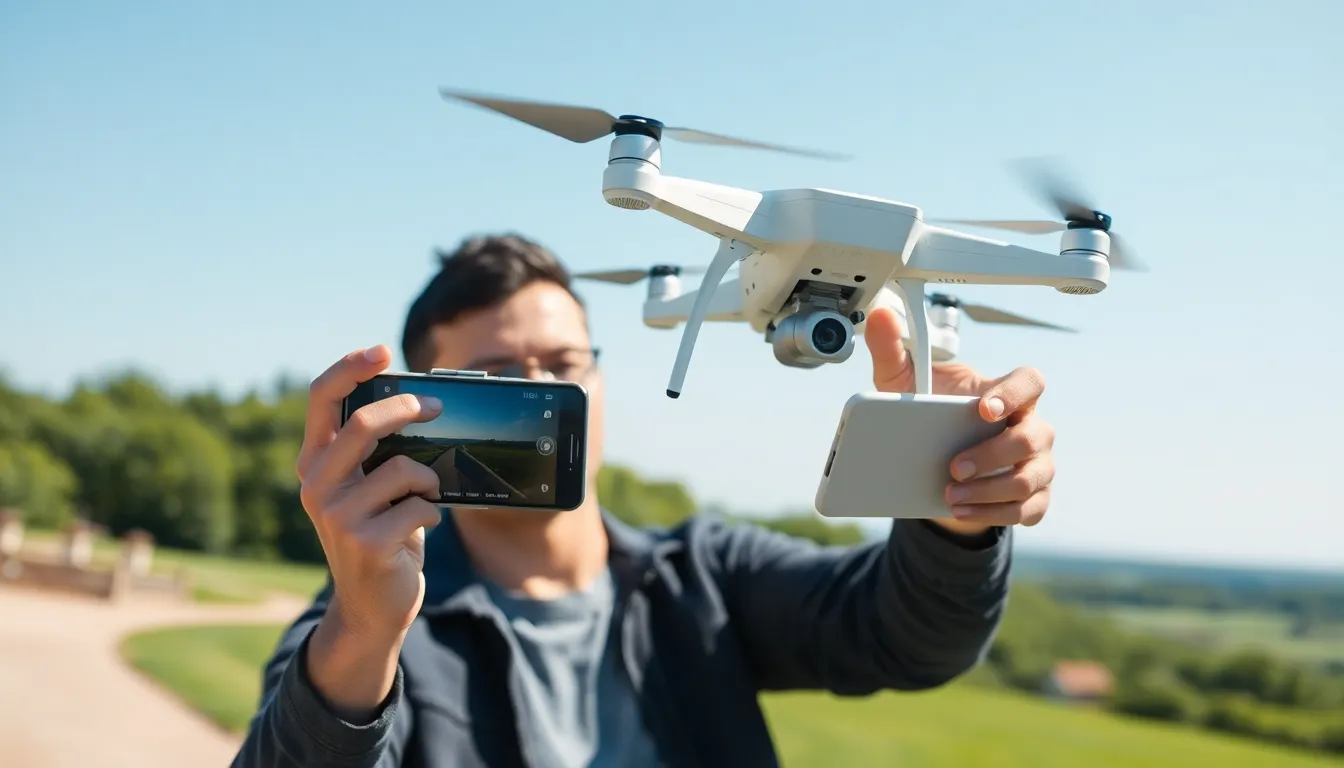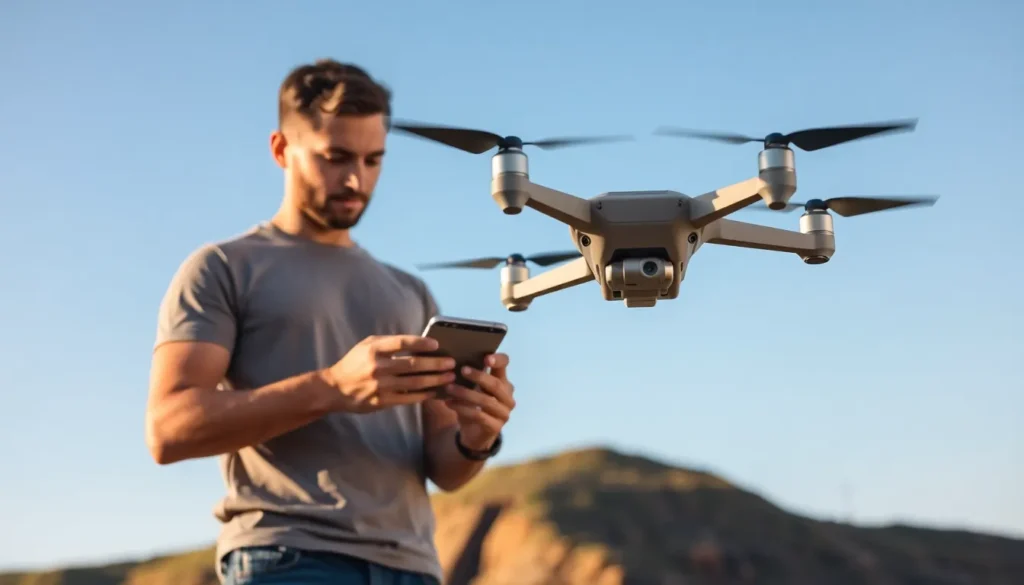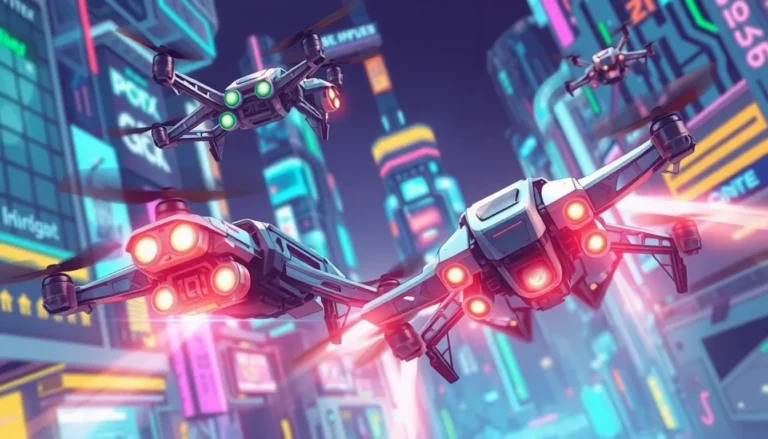Table of Contents
ToggleDrones have taken to the skies and transformed everything from photography to delivery services. But what’s the secret sauce behind these flying gadgets? It all boils down to the magic of drone app controls. Imagine piloting a high-tech bird with just a few taps on your smartphone—it’s like being a wizard without the pointy hat!
Overview Of Drone App Controls
Drone app controls serve as the interface between users and their drones, simplifying navigation and enhancing overall flying experience. These controls enable the management of various drone functions, including takeoff, landing, and aerial maneuvering. Users can access critical features through their smartphones, making piloting more approachable, even without prior experience.
Touchscreen controls typically include virtual buttons for essential functions. Users can initiate takeoff and landing sequences with just a tap. A live video feed often displays on the app, providing real-time visuals from the drone’s camera. This feature allows for better decision-making during flights.
GPS integration plays a vital role in drone app controls. Drones can follow predetermined flight paths or return to their starting location automatically if the signal is lost. Furthermore, users can set up geofencing parameters to prevent drones from flying into restricted areas.
Moreover, various apps offer customizable settings to enhance user experience. Adjustments can include camera settings, such as resolution and frame rate, which leads to higher-quality aerial footage. Users also have the option to modify flight speed and response sensitivity, tailoring controls to match their skill level or specific flight conditions.
Drones equipped with advanced software features allow for automated flight modes. Modes like follow-me and waypoint navigation help users capture unique shots without intensive manual control. These functionalities showcase the versatility of drone app controls, attracting both recreational and professional pilots.
Knowing how to utilize drone app controls effectively can significantly impact the flying experience, making it essential for users to familiarize themselves with all available features for optimal performance.
Key Features Of Drone App Controls

Drone app controls enhance user interaction, providing essential functionalities for flight management. Their intuitive design contributes to a seamless experience.
User Interface Design
User interface design emphasizes simplicity and clarity. Touchscreen layouts feature large virtual buttons for functions like takeoff and landing. Visual elements guide users, making navigation straightforward. Streamlined menus allow quick access to critical features. A live video feed displays real-time footage, improving situational awareness. Icons and text labels enhance comprehension, aiding both new and experienced pilots.
Control Options
Control options are diverse, accommodating various user preferences. Pilots can manipulate altitude, direction, and speed with precision. Gesture controls offer an innovative way to navigate without buttons. Voice commands may also assist in hands-free operation, promoting convenience. Many apps incorporate joystick-style controls for a familiar gaming experience. Automated flight modes like follow-me simplify capturing dynamic shots, appealing to creative users.
Customization Settings
Customization settings allow users to adjust functionalities for optimal performance. Pilots can modify camera settings, including resolution and frame rate, enhancing image quality. Flight parameters, such as response sensitivity and maximum altitude, can also be tailored. Geofencing settings provide a safety net, preventing accidental entry into no-fly zones. Users appreciate detailed logs of flight data, helping analyze performance and refine future flights.
Popular Drone Apps And Their Controls
Drone apps significantly enhance user experience by providing intuitive controls for various functionalities. Below are reviews of three popular drone applications known for their effective controls.
App A Review
App A offers a user-friendly interface, featuring large virtual buttons that simplify essential maneuvers like takeoff and landing. Users can view a live video feed from the drone, ensuring they maintain a clear perspective during flights. GPS integration allows the drone to follow pre-set paths seamlessly. Customizable settings include options for adjusting camera resolution and flight speed, catering to different user preferences. Furthermore, App A includes automated flight modes, making it suitable for both novices and experts alike.
App B Review
App B stands out with its advanced flight management features. This app enables users to control their drone using intuitive gesture controls, allowing a hands-free experience. Essential functions are easily accessible through a streamlined menu, improving navigation efficiency. The app’s geofencing capabilities enhance safety by keeping drones away from restricted zones. Additionally, detailed flight logs assist in performance tracking, enabling users to refine their flying techniques and achieve better results.
App C Review
App C excels in customization and user engagement. Users can adjust flight parameters, including altitude and speed, providing flexibility for various environments. The interface incorporates voice command capabilities, making it easier to execute complex maneuvers. A live telemetry feed gives real-time data, enabling informed decision-making during flights. App C’s focus on intuitive design and safety features enhances its appeal to both hobbyists and professional pilots.
Tips For Using Drone App Controls Effectively
Mastering drone app controls enhances the overall flying experience. Familiarity with the user interface significantly aids quick navigation to essential functions like takeoff and landing. In addition, utilizing the live video feed ensures real-time decision-making during flights.
Adjust settings before each flight for optimal performance. Users can modify camera resolution and frame rate to capture quality footage efficiently. Speed and response sensitivity should also align with the intended flight scenario.
Understanding GPS integration is crucial for automated tasks. Utilizing features such as geofencing prevents drones from entering restricted areas, ensuring compliance with regulations. It’s wise to set these parameters before flights to avoid potential issues.
With customizable controls, pilots can tailor their experience. Adjusting flight modes, like follow-me or waypoint navigation, caters to different skill levels and objectives. Experimenting with innovative features, including gesture controls or voice commands, enhances convenience and enjoyment.
Regularly reviewing detailed flight logs provides valuable insights. Analyzing performance data encourages pilots to refine their techniques for future flights. Engaging consistently with the drone app fosters improved familiarity with its capabilities.
Exploring community forums often yields new tips and tricks. Learning from others who have experience with specific drone applications can be beneficial. Following these strategies leads to greater confidence and proficiency in using drone app controls.
Mastering drone app controls is vital for anyone looking to enhance their flying experience. With intuitive interfaces and customizable settings, these apps empower users to navigate their drones with ease. The integration of features like GPS and geofencing not only improves safety but also allows for more sophisticated flight patterns.
As technology continues to advance, staying updated on the latest software features can elevate both recreational and professional piloting. Engaging with communities and consistently reviewing flight logs can further enhance skills and confidence. By effectively utilizing drone app controls, users can unlock the full potential of their drones and enjoy a seamless flying experience.







